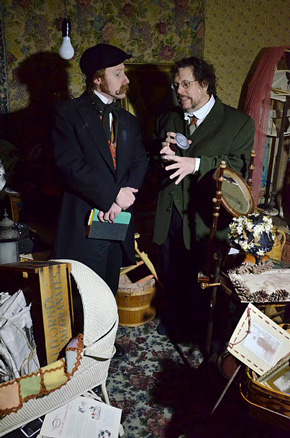
Collectors, stockpilers, scavengers and archivists all have their limits, but there was nothing to stop the wealthy and privileged Collyer brothers from saving everything, and so they did—living in a house with rooms filled floor-to-ceiling with miscellany acquired over fifty-plus years. Mark Saltzman is the most recent of many writers to find in this eccentric compulsion a lesson for our own society, reflected in the play titled, Clutter: The True Story of the Collyer Brothers Who Never Threw Anything Out.
To create a mountain of debris for Richard Greenberg's The Dazzle, Steppenwolf Theatre merely strapped a portion of their extensive prop warehouse to a wagon and wheeled it into view. Compare this with MadKap Productions' performance space, which must crowd the Collyer mansion into an alcove fronted by a semi-transparent scrim on a shallow stage flanked by minimal wing space. Further complicating matters is the necessity of the various gewgaws being carried in during the course of the play's action, gradually accumulating onstage while still allowing actors to move about without touching their invisible "wall."
This task is right up Mary O'Dowd's alley—almost literally. "I live in the Western suburbs," says the property designer whose intricately-detailed decor has enhanced such Ivan Albright-styled environs as Signal Ensemble's Real Inspector Hound, "so I drive around villages on garbage nights looking for free curbside finds. There are also some great thrift shops in the area, and dumpsters by shopping malls for things like boxes or newspapers. Oh, and I also borrow from my mother sometimes, or barter from other theaters."
Do you ever have to build from scratch? "Some things I make—the Model T front seat in Clutter, I pieced together from a curbside wicker table, along with lumber scraps, foam pillows, floral wire, and several yards of vinyl. For the horse's skull, I opted for paper-mâché over the retail price of $3000. My husband, let me add, is a skilled handyman who often helps me construct special items like the double-barreled sawed-off shotgun for Columbinus. He's also very understanding about letting me store stuff at home." She winks conspiratorially, "The secret to a successful marriage is separate garages!"
Did the furnishings all arrive at the theater at once? "Since I drive a small car, I usually bring stuff in increments and keep it at the theater, but this [production] was a rental, which meant nothing could be moved in ahead of time. I stored the props in our rehearsal space, then on the load-in date, I transported it to the Greenhouse in a rented truck, with the help of our stage manager, Cate [Anderson]—bless her heart!"
How does the assemblage fit backstage? "No square inch is wasted! The actors and the crew are wonderful at adapting to the changing offstage landscape. I'm buying two more canoe paddles tonight and I've prepared some extra items against the possibility of something breaking—not the horse's skull, I hope, which took a long time to make."
Does it ever bother you that the contributions of prop designers usually go unrecognized? "I love my job—even if the Jeffs and Tonys don't acknowledge the existence of props people. Despite this production's many challenges, it was worth every bit of the effort!"
Clutter runs through March 11 at the Greenhouse
Mary Shen Barnidge
Contributing Writer

 Follow Us On Twitter
Follow Us On Twitter